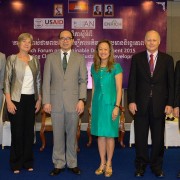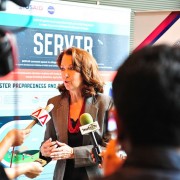Gender lens investing is focused on using gender data points to see opportunity and mitigate risk for better investment decisions. These include making money available to enterprises owned by women, focusing on workplace equity and employment opportunities for women, and investing in products and services that benefit women and girls. These investments can achieve financial results as well as gender-equitable social change. In this report, USAID and Criterion Institute identify the leaders in finance and gender who are active in current activity, and committed to pursuing the vast opportunities to continue advancement of the field of gender lens investing in Asia.
The U.S. Agency for International Development’s Low Emissions Asian Development program works with regional governments, businesses and institutions toward sustainable, low-carbon economic development, or “green growth,” across all economic sectors. The five-year program promotes regional cooperation to develop and implement low emission development strategies, improve greenhouse gas inventories and advance carbon markets in 11 countries: Bangladesh, Cambodia, India, Indonesia, Laos, Malaysia, Nepal, Papua New Guinea, the Philippines, Thailand and Vietnam.

PHNOM PENH, September 17, 2015 — Businesses, financial institutions and civil society organizations from Cambodia’s clean energy sector met today to accelerate clean energy investment and share knowledge about Cambodia’s emerging industry trends in clean energy, particularly solar power.

When I became the U.S. Ambassador to the Association of Southeast Asian Nations, I knew that the issues of territorial disputes, food security, and human rights would feature prominently in my new role. What I have found during my time in the region, however, is that there is another very serious issue that sews a common thread among each of these issues: the degradation of marine and coastal ecosystems due to overfishing and illegal, unreported and unregulated fishing.

We at USAID are proud to partner with NASA on SERVIR because we – and the development community more broadly – are just scratching the surface of how geospatial information can be applied to address a wide range of development challenges. As SERVIR has already been doing in Eastern and Southern Africa and across the Hindu-kush Himalaya region, SERVIR-Mekong will help governments and other key decision-makers in Cambodia, Laos, Myanmar, Thailand and Vietnam take advantage of NASA’s publicly available satellite imagery and geospatial analyses.







Comment
Make a general inquiry or suggest an improvement.